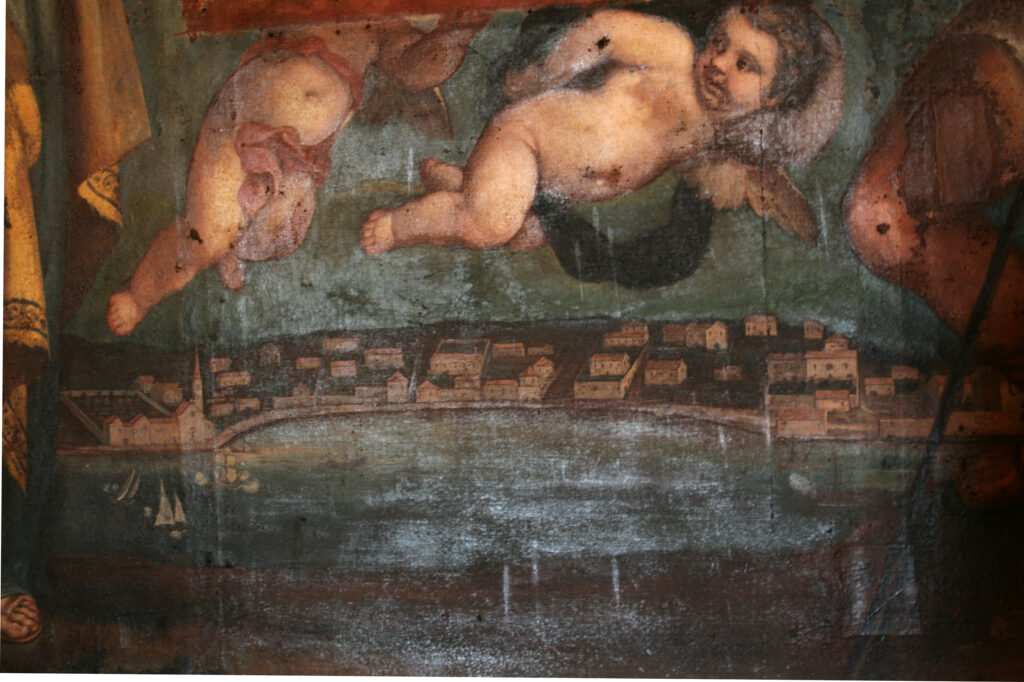
In the invaluable De administrando Imperio (`On the Governance of the Empire’) by Constantine VII Porphyrogenitus, a Byzantine emperor from 913 to 959, the following was written:
The city of Rausij is not called `Rausi‘ in the language of the Romans, but because it stands on cliffs, and the cliff is called `lau‘ in Roman speech, its residents were thus called `Lausaji”, i.e. `those who inhabit the cliffs‘. Due to the general tendency of people to often corrupt names by altering certain letters, the name was changed and they were later called `Rausaji‘. In ancient times, these same Rausaji ruled a city called Pitaura. However, when the Slavs conquered the other cities in that province, that city was also occupied, and some of its residents were slaughtered and others taken prisoner, while those who managed to escape and save themselves settled in a steep spot, where the city of Rausij is now. They first built a small town, and afterwards enlarged it, and then later extended its rampart until the city reached its present size, owing to their gradual spreading out and increase in population.
Despite making the connection between ancient Epidaurum and Ragusium (today’s Dubrovnik) in the middle of the 10th century, Porphyrogenetus was not the first to do so. Somewhat earlier, probably in the 6th or more likely the 7th century, an anonymous cosmographer from Ravenna, in an effort to compile a world geography compendium based on various late antique sources, wrote five volumes of descriptions of various regions, consisting of lists of cities in each area. In the description of the province of Dalmatia, a particular city is listed along with cities such as Buccinium (Ulcinj), Butua (Budva), Decadaron (Kotor), Racinium (Risan). The city in question is no other than Epitaurum id est Ragusium (`Epidaurum, i.e. Ragusium). The meaning of this quote has been much debated. Does this mean, as Constantine Porphyrogenetus would conclude a few centuries later, that the residents of ancient Epidaurum, fearing the attacks of the Avars and Slavs in which their city was ultimately destroyed, fled to a nearby area and founded a new city there? Or, as contemporary authors suggest and archaeological remains confirm, that a settlement on the site of today’s Dubrovnik already existed in ancient times, serving as the foundation from which an early medieval city would later develop?
In his attempt to clarify term `Epitaurum id est Ragusium‘, the historian and archaeologist Slobodan Čače interpreted that the sources used by the unknown author to create his compendium described an earlier layout of cities in the province, thus his work provides information on the time when the two settlements, Epidaurum and Ragusium, existed simultaneously. In his opinion, the aforementioned phrase means that Epidaurum was situated on the main road which branched off towards Ragusium.

From: Zelić, Danko. 2012. Radovi Instituta za povijest umjetnosti, 36.
It is certain that Epidaurum was the urban center of the colony in the first centuries of Common Era, while other areas, such as Ragusium, developed over time and gradually assumed certain urban functions. It would be difficult to draw any concrete conclusions concerning the destruction of Epidaurum, as well as the genesis of the city of Dubrovnik, based solely on written sources and without systematic archaeological research.
Following the development and expansion of Dubrovnik, its connection to Epidaurum was used in order to create an image of Dubrovnik’s glory and antiquity. This tradition certainly proved to be beneficial to Dubrovnik’s efforts of acquiring the Konavle region, since the noble families of Republic of Dubrovnik presented themselves as the regions’ successors by claiming that `they were born of people from the old city of Epidaurum‘. Not only did the Dubrovnik nobility use this myth of origin in order to acquire new territories, but they also exploited it in order to strengthen their privileges in relation to the common people and further secure their monopoly on power.
In the 16th century, the humanist intellectuals from Dubrovnik began exploring this topic. Nikola Ranjina writes that the settlement on the site of Dubrovnik existed much earlier, prior to the destruction of Epidaurum. He also claims that the settlement in question was founded 4,000 years after the creation of the world, 24 years before the destruction of Troy and 470 years before the foundation of Rome. Ludovic Cerva Tubero, Serafin Razzi, Marcus Sylvius and Mavro Orbini also write about Epidaurum, its destruction and the origin of Dubrovnik, while certain individuals and even the Dubrovnik government initiated archaeological research of Epidaurum remains.
The stonework of the destroyed ancient Epidaurum buildings was eventually used for the construction of both Cavtat and Dubrovnik, which serves as another connection between the two settlements.